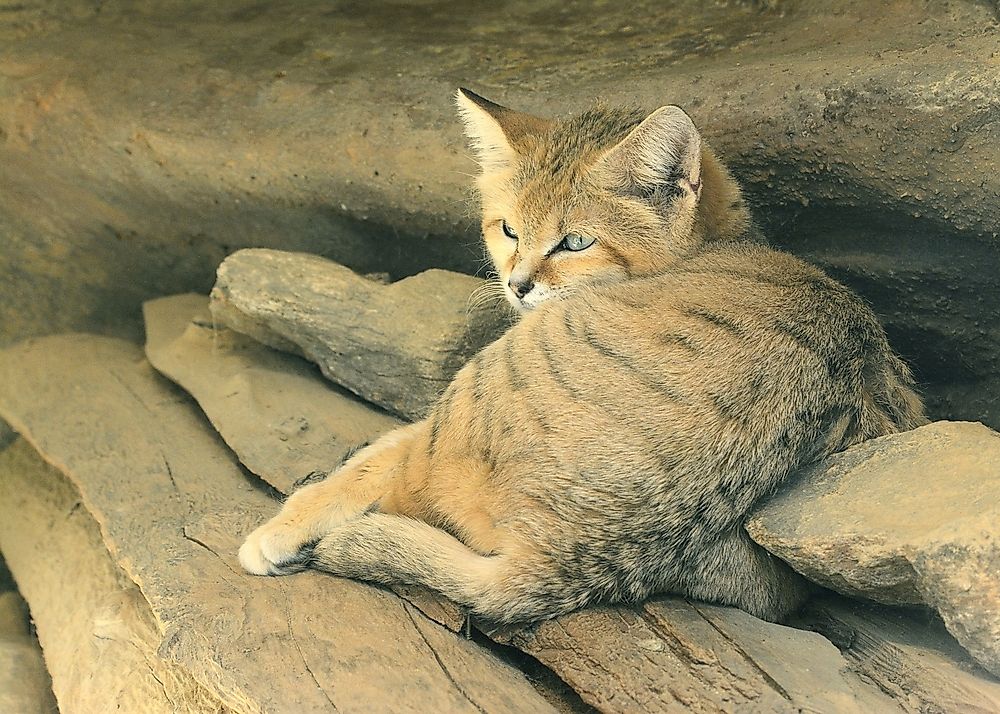Sand Cat Facts: Animals of the Desert

The sand cat is the only cat which lives in the desert as it can survive for long periods of time without drinking water. There are four sub-species of sand cats that can be found across Africa, the Middle East, and Asia. The sand cat is near threatened because of its fragmented population which has indicated a declining trend. The cats can survive in both stony and sandy deserts. Its body features are adapted to a desert environment and are capable of tolerating either extremely high or low temperatures. The cats are difficult to breed in captivity with less than 200 held in zoos.
Physical Description Of The Sand Cat
The sand cat is a relatively small animal that can reach 15 to 20 inches in length including head and body. The legs are short, but the tail is relatively long measuring between 9 and 12 inches. The ears are set low and measure 2 to 2.8 inches, giving a flat appearance. A mature cat weighs between 3.3 and 7.5 pounds. The ear canal is wide while the pinnae are triangular giving the cat a high sense of hearing. The head is brownish while the lips, chin, throat and the underpart are white. A faint maroon line runs from the corner of each eye across to the chick. The fur is light sandy brown while the marking varies among the sub-species. Some have spots or stripes, or both while some have neither spots nor stripes. The forelimbs have short and sharp claws while the claws on the hind limbs are short and blunt. The paws are covered with dense fur which prevents its feet from burning while walking on hot sand.
Diet Of The Sand Cat
Sand cat is a carnivore and uses its hearing skills to hunt for prey. Its diet consists of small rodents, insects, lizards, and snakes. It also hunts birds such as desert lark and feeds on desert reptiles such as gecko and sand vipers. It hides its leftovers of food in the sand and satisfies its moisture requirements from the food. It can survive without water for a couple of months. Sand cat hunts at night to avoid the high daytime temperatures.
Habitat And Range Of The Sand Cat
Sand cats are found in both stony and sandy deserts. They are distributed throughout the deserts of North Africa and Asia. The cat prefers flat terrains with sparse vegetation where it can get food. It occurs in Western Morocco, Algeria, and the rocky deserts of Egypt. Sand Cats have also been sighted in Libya and Mali in Africa, and Southern Israel. In Asia, sand cats occur throughout the Karakum Desert and Kyzylkum Desert. They have also been sighted near Palmyra in Syria. Sand Cats live in burrows abandoned by rodents or foxes.
Behavior Of The Sand Cat
Sand Cat leads a solitary life except during the mating season. It communicates through scents and marks objects within its range using its claws and urine spray. It buries its feces in the sand and makes loud, high-pitched barking sound when looking for a mate. The cat is nocturnal and only comes out of the burrows at night when the temperatures are favorable. It hides its food in the ground and can dig very fast to extract it from the ground.
Reproduction Of The Sand Cat
Pregnancy in female sand cat lasts 59 to 63 days ending in 2 to 4 kittens. It can give birth twice a year with kittens weighing 40 to 80 grams at birth. The kittens grow rapidly, and by the 5th week, they can consume solid food. The kittens are ready for independent life at the age of eight months and reach sexual maturity at the age of about 12 months.











